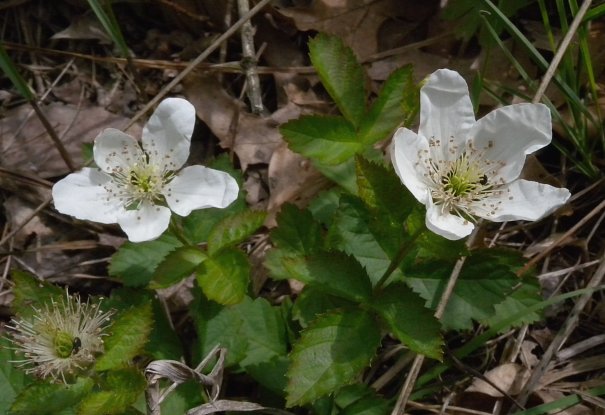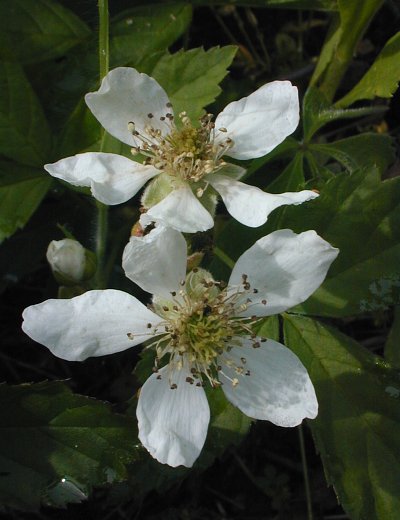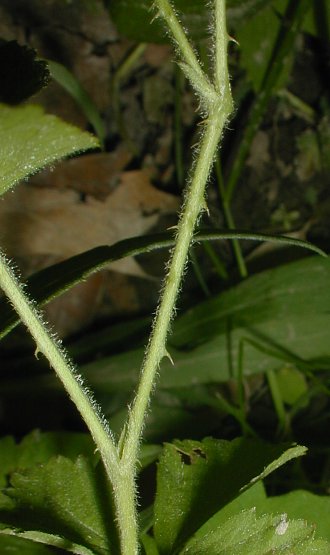Description: This woody vine produces stems up to 15' long that trail along the ground; some of the flowering stems are more erect and up to 4' tall. Old stems are brown and woody with scattered hooked prickles. Young stems are green with scattered hooked prickles; they are also more or less hairy. Alternate compound leaves occur at intervals along the stems. They are usually trifoliate with 3 leaflets; less often, compound leaves with 5 leaflets occur. These leaflets are up to 3" long and 1" across; they are ovate, doubly serrate along the margins, and mostly hairless. The underside of each leaflet is pale green, rather than white or velvety. Most leaflets have wedge-shaped bottoms and tips that taper gradually. The terminal leaflet has a short petiole (petiolule), while the lateral leaflets are sessile. Each compound leaf is connected to the stem by a long petiole. At the base of this petiole, there is a pair of small linear stipules.

Young stems often terminate in a corymb of 1-5 flowers. Each flower is about 1-1¼" across when fully open; it consists of 5 white petals, 5 lanceolate green sepals, and numerous stamens that surround a green cluster of carpels. The petals are longer than the sepals and they often have a somewhat wrinkled appearance. The blooming period occurs from mid-spring to early summer and lasts about 1-2 months. The flowers open up during the day and close at night. Each fertilized flower is replaced by a compound drupe up to 1" long that is longer than it is broad. A fully ripened drupe becomes purple-black or black and it has a tart-sweet flavor. This drupe does not detach from its receptacle easily. The root system consists of a woody taproot. This woody vine spreads by reseeding itself; sometimes, the tips of young stems will root in the ground, forming vegetative offsets.

Cultivation:
This plant typically grows in full to partial sun and mesic to dry
conditions.
It tolerates different kinds of soil, including those containing loam,
clay-loam, sand, or rocky material.
Range & Habitat:
The native Common Dewberry is common in the southern half of Illinois;
it is less
common or absent in the northern half of the state, particularly in the
NW area (see Distribution
Map). Habitats include mesic to dry savannas and sandy
savannas, woodland borders, meadows in wooded areas, and
abandoned fields. Common Dewberry is found in both sandy and
non-sandy habitats. Occasional wildfires
that remove tall woody vegetation tend to increase the population of
Common Dewberry.

Faunal
Associations:
The nectar and pollen of the flowers attract primarily bees, including
honeybees, bumblebees, little carpenter bees (Ceratina spp.),
long-horned bees (Synhalonia spp.), cuckoo bees (Nomada spp., Coelioxys
spp.), leaf-cutting bees (Megachile spp.), mason bees (Osmia spp.,
Hoplitis spp.), Halictine bees (including green metallic bees), and
Andrenine bees. Other floral visitors include Syrphid flies,
miscellaneous wasps, small to medium-sized butterflies, and skippers
(Robertson, 1929; Wilhelm & Rericha, 2017; Evans, 1986; Grundel
& Pavlovic, 2000). Other insects feed destructively on Common
Dewberry (Rubus flagellaris) and other Rubus spp.
by consuming their leaves, sucking their sap, boring through their
woody stems, etc. This group of latter insects includes the larvae of
metallic wood-boring beetles, larvae of long-horned beetles, larvae and
adults of leaf beetles, plant bugs, stink bugs, aphids, leafhoppers,
treehoppers, katydids, thrips, larvae of sawflies, larvae of the
butterfly, Striped Hairstreak (Satyrium liparops strigosum), and larvae
of many moths, including Geometer moths, midget moths (Nepticulidae),
owlet moths (Noctuidae), and Tortrix moths. The Insect Table provides more information about these insect feeders. The fruits of Common Dewberry and other Rubus spp. are an important source of food for many kinds of birds, including songbirds, upland gamebirds, and crows. The Bird Table
provides more information about these species. Many mammals also use
these semi-woody plants as a source of food. Examples include the Elk
(leaves, stems), White-tailed Deer (leaves, stems), Domesticated Goat
(leaves, stems), and Cottontail Rabbit (primarily stems). Other mammals
feed on the fruits; this includes the American Black Bear, Gray Fox,
Red Fox, Virginia Opossum, Raccoon, Fox Squirrel, Eastern Chipmunk,
Least Chipmunk, White-footed Mouse, Deer Mouse, Woodland Jumping Mouse,
and Meadow Jumping Mouse (Schneider et al., 2006; Martin et al,
1951/1961; Blackmore, 1998; Haugen, 1942; Romain et al., 2013;
Hamilton, 1941; Whitaker & Mumford, 1970). In addition, because of
their low habit of growth, the fruits of Common Dewberry and other
dewberries are eaten by the Wood Turtle, Eastern Box Turtle, Ornate Box
Turtle, and Eastern Mud Turtle (Lagler, 1943; Ernst et al., 1994).
Animals that consume the fruits spread the seeds to new locations.

Photographic
Location:
A meadow in a wooded area at Orchid Hill in Vermilion County,
Illinois; a sandy meadow at Irwin Prairie State Nature Preserve in
Lucas County, Ohio; and the Indiana Dunes State Park in NW Indiana.
Comments:
The compound drupes (fruits) of Common Dewberry are edible to humans;
when they are fully ripened, their flavor is pleasant. Common Dewberry
can be distinguished from most Rubus spp.
(Blackberries) by its vine-like habit. There are other Rubus
spp. that are woody vines in various areas of the state, but
they are less common. One of them, Rubus trivialis
(Southern Dewberry) is restricted to southern Illinois. Its appearance
and growth habit is similar to Common Dewberry, but the young stems of
Southern Dewberry usually have sharp bristles and prickles. The young
stems of Common Dewberry have soft hairs and prickles, but not sharp
bristles. The leaves of Southern Dewberry are evergreen, while those of
Common Dewberry are deciduous. The appearance of Common Dewberry is
somewhat variable across its broad range, although different varieties
have not been described for Illinois.